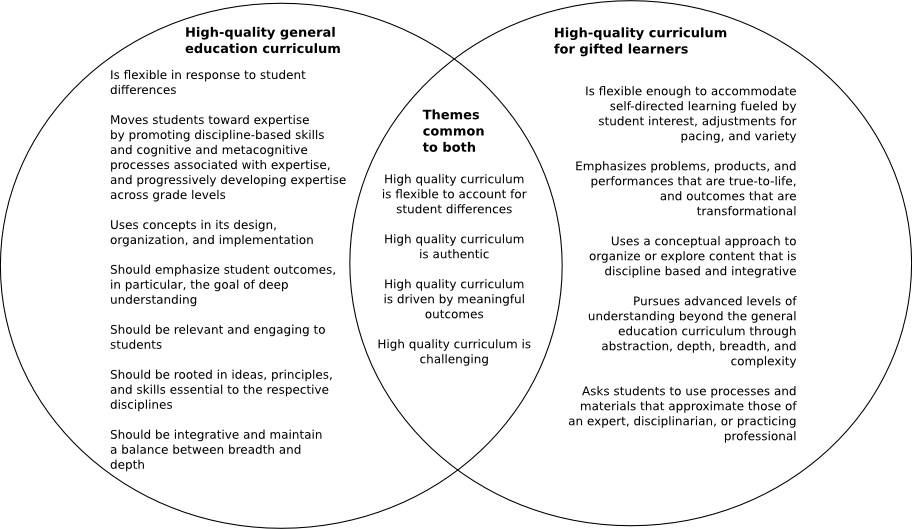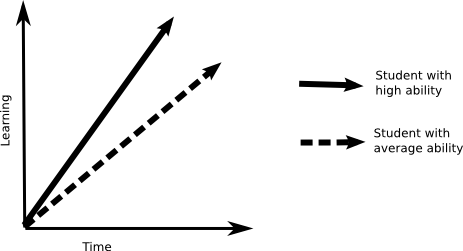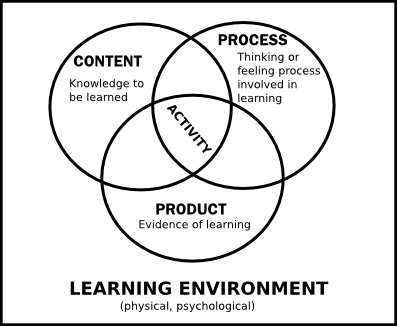This chapter contains an introduction to curriculum differentiation for students with exceptional learning abilities, descriptions and examples of 30 strategies to differentiate learning experiences for them. A description of each strategy is followed by a list of behaviors that indicate it is needed. Examples and resources are also provided. The ideas presented here are based on the work of Maker & Nielson in Curriculum Development and Teaching Strategies for Gifted Learners.[1]
Differentiated Curriculum For All and For High Ability Learners
In the ways and to the extent students are similar,
Their curriculum should be similar.
In the ways and to the extent that they are different,
Their curriculum should be different.[2]
Although the notion of differentiation has appeared the education literature since the 1950s, it has gained greater significance and attention as the diversity of students in today’s classrooms has increased.
Tomlinson[3] defined curriculum differentiation for all students as “ensuring that what a student learns, how he/she learns, and how the student demonstrates what he/she has learned is a match for that student’s readiness level, interests, and preferred mode of learning.” This implies a commitment to accommodating individual learner characteristics. That commitment is also evident in the sets of principles of high quality curriculum for general and gifted education Hockett[4] derived from general and gifted education literature (see Figure 1). Flexibility “to account for student differences,” a theme common to high quality curriculum in both general and gifted education, is operationalized in practice as curriculum differentiation.
Figure 1: Principles of high-quality curriculum in general and gifted education, and themes they have in common

The principles for general education (left circle in Figure 4.1.1) are appropriate for students identified as gifted, however, they need to be adjusted to respond to the capacities that distinguish the learning of students with high ability. Those capacities are evident in the “Brilliant Behaviours” they demonstrate: learning more quickly, greater depth and complexity of conceptual understanding, longer concentration on tasks, greater curiosity, a greater preference for solving more complex problems[5], motivation, advanced interests, communication skills, memory, insight, imagination, creativity, inquiry, reasoning, and humor.[6] When these learner characteristics are accommodated, the principles are qualitatively different from those for learners in general education who do not share these characteristics. The results are apparent in the circle on the right,in the five principles of high-quality curriculum for gifted learners. The principles for gifted learners highlight features of curriculum that respond to the exceptional abilities of these individuals.
The commonalities among the principles for general and gifted education (overlapping area between circles) have contributed to confusion surrounding the distinctions between them. Isn’t it all just “good education”? Aren’t best practices for gifted students good for all students? The answer to these questions is, “It depends…” The principles do overlap however there are significant, qualitative differences between them. It is those differences that distinguish curricula differentiated for high ability learners from curriculum differentiated to respond to the needs of students with less ability. The differences in the practices reflect the differences in the students. This is not elitism; it is flexibility. It is responsiveness to the characteristics that distinguish these groups of learners.
Differences in ability result in differences in what and how much is learned from appropriately differentiated learning experiences. The difference in the slope of the lines in Figure 4.1.1 indicate the academic benefits of the match between learner and curriculum accumulate over time.
Differentiation should be a constant best practice in classrooms, not an occasional event. The learner characteristics that create a need for it are constants and so should be the response to them. The subjects in which an individual’s abilities are strong (frequent, intense, consistent) will require on-going differentiation to ensure the differential benefits continue to accumulate. Motivation and attitudes torward school, as well as academic achievement, may suffer when students with high ability are offered unchallenging curriculum. Boredom and challenging behaviors are likely outcomes.
Differentiation should also be systematic. The system that guides it should offer a rationale and research base for its recommendations. Both should be connected to learner characteristics. The system becomes a tool for communication with curious students, parents, teaching colleagues and administrators. A systematic approach also allows teachers to monitor successes and on-going challenges, tracking them for changes and reporting purposes.
Figure 4.1.1 Differential benefits of differentiated curriculum

The Four Elements of Curriculum
Every learning activity in a curriculum is composed of four elements: content, process, product and learning environment.
Content: The content of curriculum is the new knowledge, skills, behaviors and attitudes to be learned in the activity. Content can be drawn from one discipline (subject) or it may be interdisciplinary. The content in any discipline may be in the form of facts, concepts, procedures, principles, generalizations, theories, strategies, heuristics, actions, meanings, emotions, etc.
Process: The process in curriculum is in the actions (thinking, feeling, physical, etc.) students use to develop their understanding of the content. Learning processes include the way students find and work with information and resources, as well as the ways they interact with others (peers, experts, teacher, etc.).
Product: Products of learning experiences communicate the substance of what has been learned. Bright and gifted students should be expected produce evidence in which they demonstrate their potential and their growth in understanding, not their age. Assessment criteria and procedures should clearly communicate this expectation.
Learning Environment: The environment in which students learn has physical and psychological features can be enhanced to increase the benefits of differentiating the contents, processes and products learning.
Each element can be modified to accommodate the characteristics of an individual or group of high ability learners. Figure 4.2.1 represents the relationship among the elements. The content, process and product take place in the learning environment. The overlapping regions indicate the elements are interdependent. This means that changes in one element are likely to have consequences for the others. For example, if the content is made more complex, students are likely to think about it differently; their thinking is likely to become more complex.
Figure 4.2.1 Interdependent elements of curriculum

Strategies for differentiating the elements of curriculum for highly able learners
Maker and her colleagues[9] proposed a system that includes 29 strategies or principles to guide efforts to differentiatecurriculum for highly able learners. They are organized in clusters addressing the four elements of curriculum.
| Content Abstractness Complexity Extracurricular topics Lives & living [Re-]Organization for learning value Real-life topics Self-selected content |
Process Complex thinking Expert methods of inquiry Individual pursuits Inquiry-based learning Open-ended experiences Flexible pacing Reflecting & debriefing Self-selected process Variety |
| Product Authentic audiences Feedback & evaluation Self-selected products Transformations Variety |
Learning Environment Accepting Complex Flexible High mobility Independent Learner-centered Open Flexible groupings |
- The seven content-related strategies focus on “concepts, ideas, strategies, images and information”[10] in curricula. They address abstractness, complexity, variety, organization for learning value, the study of people and the study of methods.
- The nine process-oriented strategies focus on “the way educators teach and the ways students use information.” [11] They include methods involving inductive teaching and learning, higher levels of thinking, open-endedness, discovery, evidence of reasoning, choice, group interaction, pacing, and the variety of processes used.
- The five outcome-oriented principles address “the nature of products expected of students” [12] when students demonstrate what they’ve learned. They recommend learning outcomes address real problems, problem finding, elements of communication, features of evaluation, transformation of content from one form to another, variety of products developed, self-selection of product format and direction of students to real audiences.
- The eight principles related to the learning environment recommend that it is learner-centered (vs. teacher-centered), independent (vs. dependent), open (vs. closed), accepting (vs. judging), complex (vs. simple), flexible (vs. rigid); involves varied groupings (vs. similar groupings) and high student mobility (vs. low).
Each principle focuses on a feature of a learning activity that may be modified in particular ways to make the activity more appropriate for many highly able learners. In upcoming pages, each principle is described, and examples and resources will be provided. Maker and her colleagues[13] have provided research evidence of their effectiveness in their publications. Maker’s collection of principles should be viewed as comprehensive, but not exhaustive. New, effective forms of differentiation are constantly emerging.
